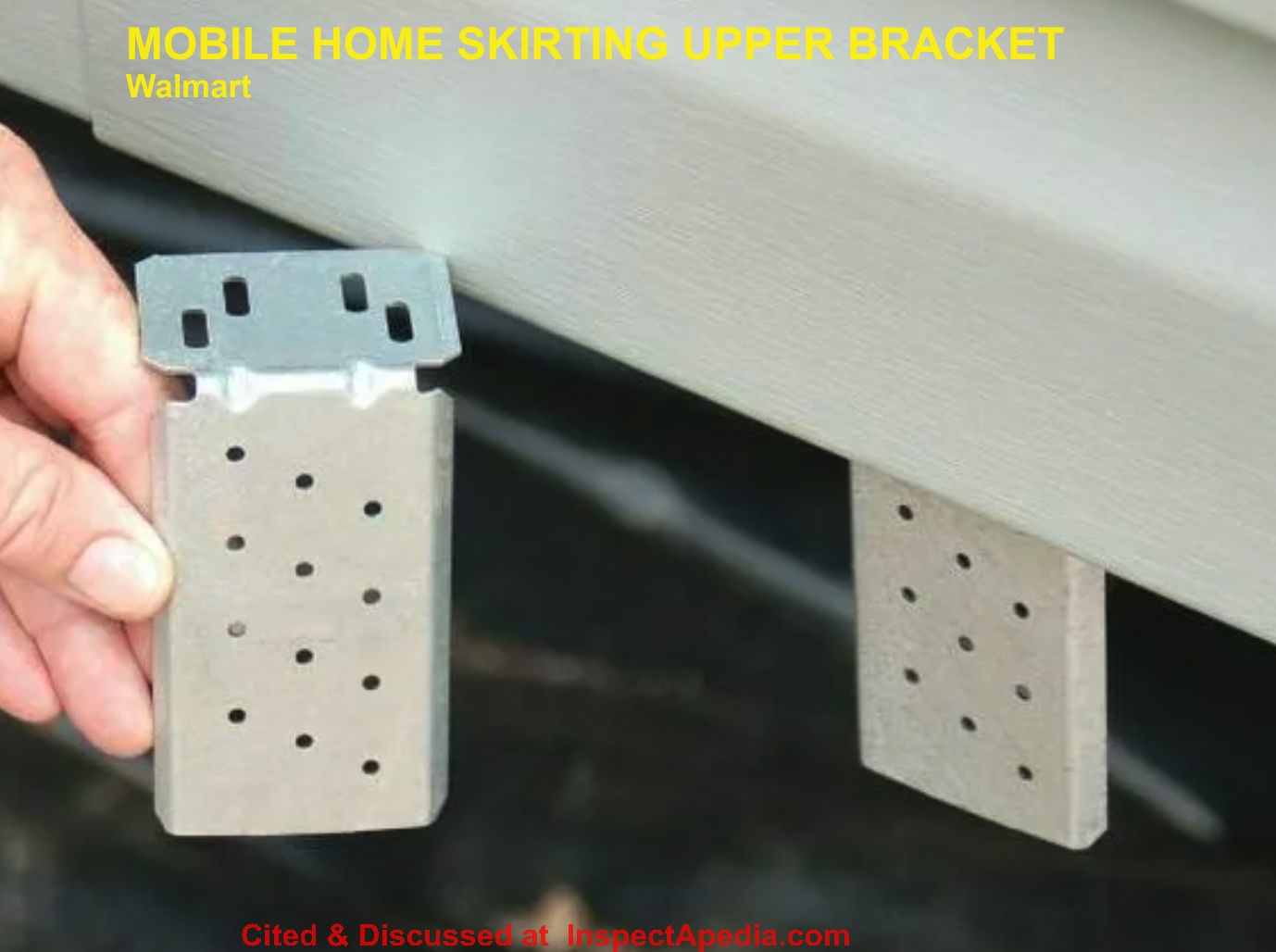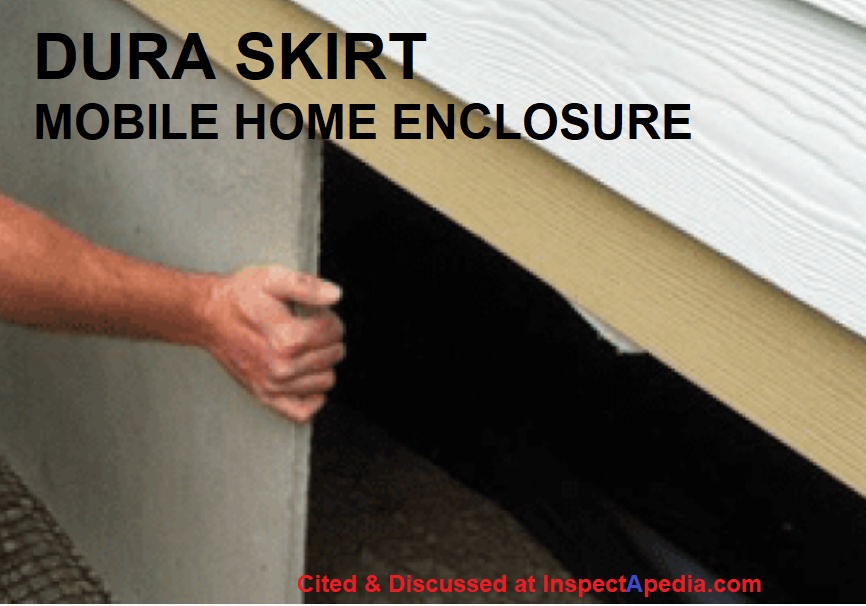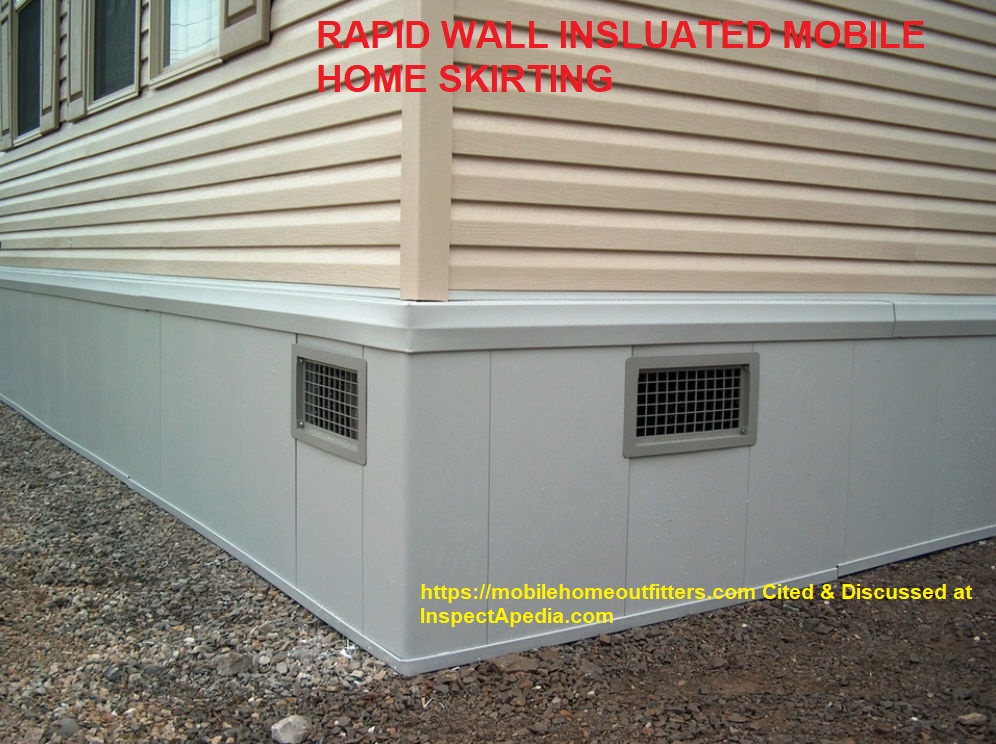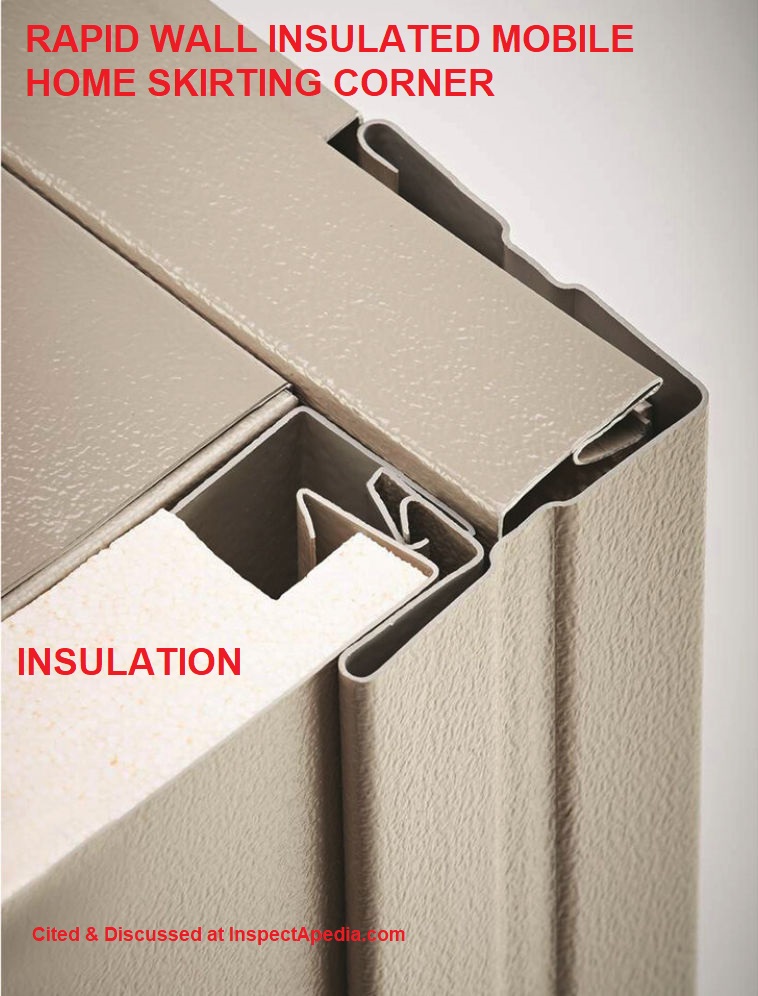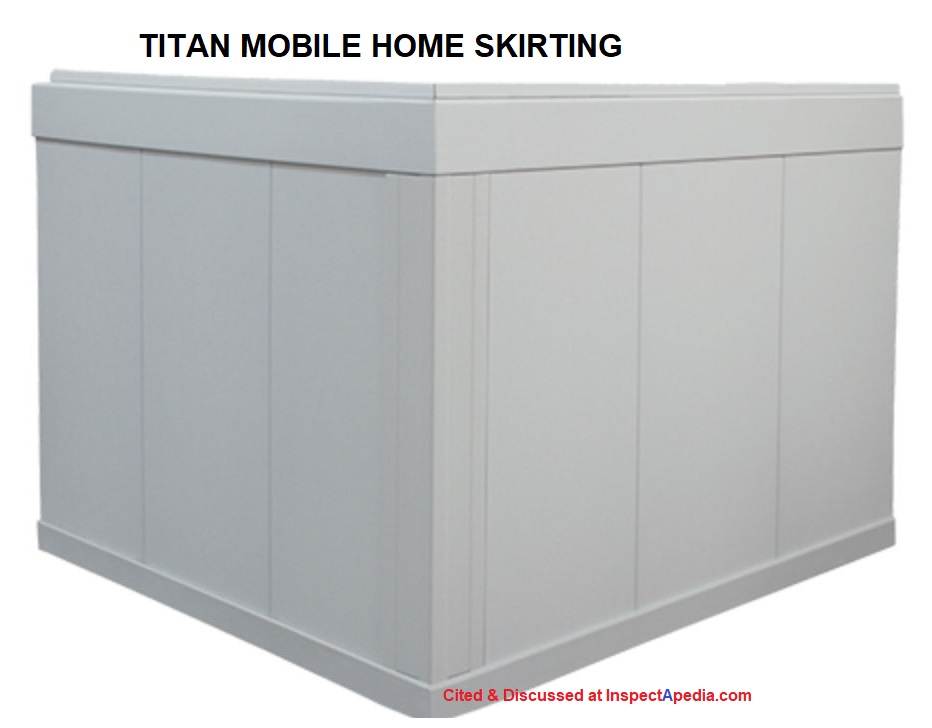 Mobile Home Skirting
Mobile Home Skirting
Mobile home, trailer, doublewide skirting & insulated skirting panels: requirements, types, sources
- POST a QUESTION or COMMENT about mobile home skirting & insulation
Most mobile home codes currently require a skirting around the unit as well as a moisture barrier on the ground below it.
Page top: Titan mobile home skirting or foundation enclosure, insulating panels, cited below on this page.
This article series discusses how to inspect, diagnose and correct problems in mobile home, doublewide, or trailer & camper insulation or ventilation systems.
InspectAPedia tolerates no conflicts of interest. We have no relationship with advertisers, products, or services discussed at this website.
- Daniel Friedman, Publisher/Editor/Author - See WHO ARE WE?
Mobile Home & Trailer Home Skirting & Crawlspace Enclosures
Bottom line: skirting is required around the open bottom of mobile homes, trailers, manufactured homes.
Add a skirt if none is provided, or inspect & repair the existing skirting to stop winds from blowing beneath the unit. In cold climates, install insulated skirting panels.
Illustration: Gorilla EPS insulated mobile home skirting panels, cited & discussed below on this page.
[Click to enlarge any image]
Article Contents
- MOBILE HOME SKIRTING BASICS
- MOBILE HOME SKIRTING ANCHORS & BRACKETS
- MOBILE HOME SKIRTING CODES
- MOBILE HOME SKIRTING SOURCES & INSTALLATION INSTRUCTIONS
- MOBILE HOME SKIRTING REDUCES STORM DAMAGE - RESEARCH
...
Mobile Home Skirting Basics
1. Crawl area ventilation:
Mobile home crawl area ventilation: with some variation by local codes depending on where you live, some skirting openings are required for ventilaton, often described as:
The skirting of a manufactured home shall be ventilated by an approved mechanical means, or by openings in the exterior facia or foundation walls.
Such openings shall have a net area of not less than one square foot for each 150 square feet of under-floor area.
Venting like this is NOT required for mobile homes located in a flood plain, though I might argue that openings or flood vents might be needed to prevent flood waters from causing the skirting or home to collapse.
2. Mobile home crawl space enclosure:
A manufactured home must have a skirting around its entire perimeter. It must be installed per the manufacturer’s installation directions or, if the manufacturer is not specific, to the standards that have been adopted in the code jurisdiction where you live.
3. Access opening:
The mobile home (manufactured home) skirting must include an operable access cover or door or opening to permit access below the home (for inspection and repair) .
4. Mechanical systems that drain or vent
Such as a dryer vent or water heater temperature/pressure relief valves must discharge to outside the skirting - that is, you cannot dump these into the crawl space.
5. Mobile home skirting materials:
Must be suitable for ground contact and must be non-combustible (to avoid a fire hazard). That means you can't use materials that will be damaged by water, moisture, or ground contact.
Typical code details might state: Metal fasteners must be galvanized, stainless steel or other corrosion-resistant material. Ferrous metal members in contact with the earth, other than those that are galvanized or stainless steel, must be coated with an asphaltic emulsion.
Skirting must not be attached in such a manner that can cause water to be trapped between the skirting and siding or trim. The skirting must be recessed behind the siding or trim.
Watch out: when working under a mobile home, manufactured home, or any tight crawl space, there may be serious health and safety hazards. More than one reader have reported getting an electrical shock while working under a mobile or manufactured home. Hazards in such tight spaces are outlined
at MOBILE HOME CRAWL SPACES and
...
Mobile Home Skirting Tie-Down Anchor Rods & Upper Brackets
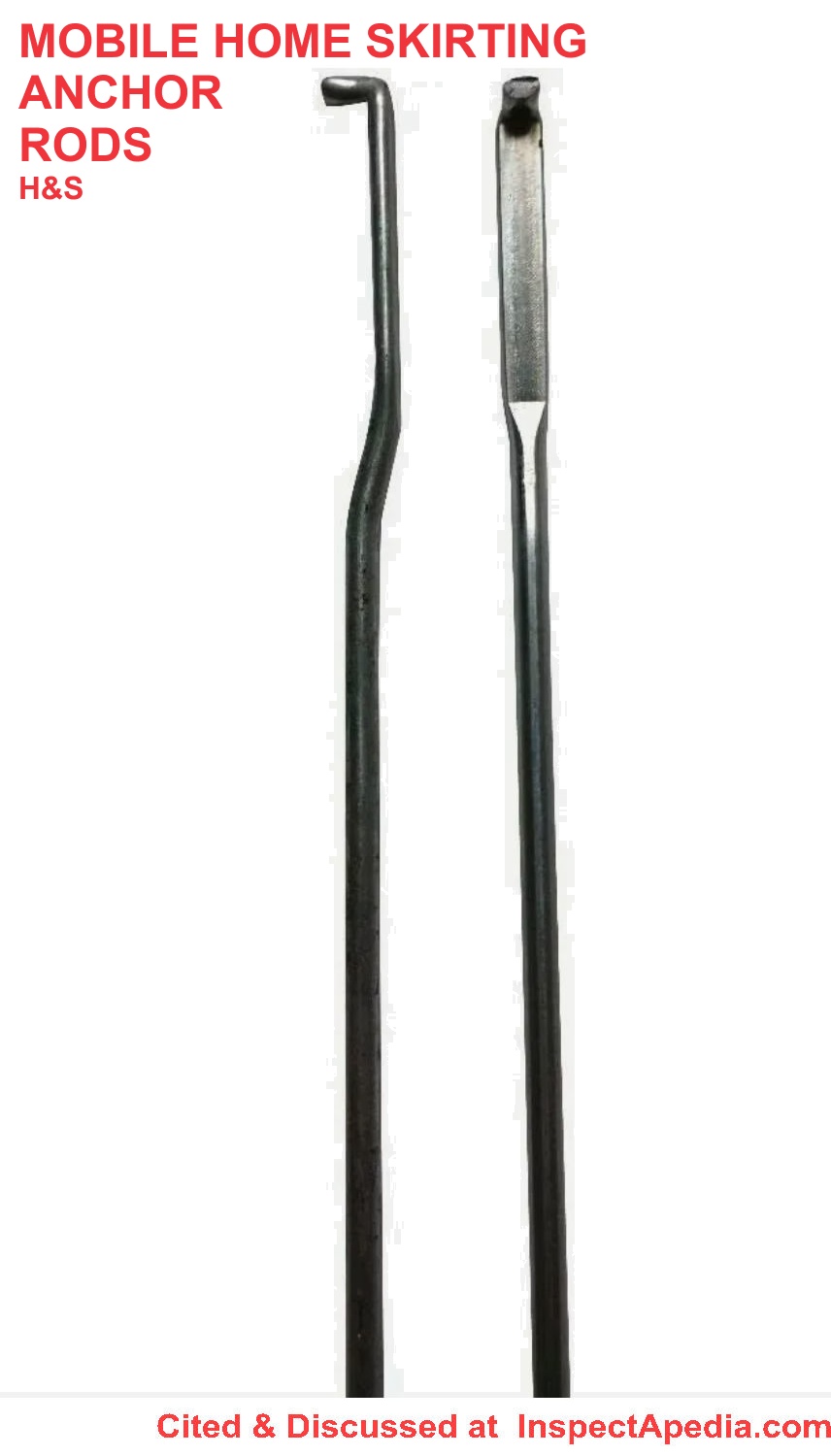 Number, Spacing, Types, Installation
Number, Spacing, Types, Installation
On 2019-09-21 by Bill Duke - how is skirting secured or tied down
Thank you for that, but I am referring specifically to some new code that relates to the skirting only and how it must be installed with something other than those spikes they normally use in the bottom runner.
In regard to Florida mobile homes. I have been told there is a new code for tying down the skirting. Does anyone have information on this?
Moderator Reply
The method of tying down the bottom edge of mobile home skirting depends on the skirting material you choose. Typically, vinyl or aluminum skirting systems are supplied with top and bottom rails that actually hold the skirting sections in place.
You'll read in the mobile home skirting code cited below on this page that the bottom rail of mobile home skirting must be "anchored" down.
These skirting bottom rail anchors are usually very simple: a spike driven through the skirting bottom rail into the soil below. Place the rails along the chalk line that was snapped to lay out the skirting. Drive spikes provided with the skirting fit into the ground through holes in the rail.
Typical mobile home skirting rods like the ones shown here from H&S Mobile Home Supplies (sold by mobile home suppliers, dealers, and online vendors) are 24" long and are a simple wire rod. These are sold in packs of 32 rods for about a dollar a rod. Other simpler ground spikes for mobile home skirting cost about 50 cents each.
Other skirting rail anchor rods look simply like a long thin nail or spike.
Just how many mobile home skirting ground spikes you need - at what intervals - depends on the length of the skirt walls and the soil conditions.
But typically you'll install a rod into the bottom skirting anchor rail at each vertical skirting section joint.
Watch out: in sandy soils, you may need to use skirting anchors that have a helical screw at the anchor bottom to provide enough lift-out resistance.
At the upper edge of mobile home skirting panels, most kits provide a bracket (like the one shown below) that screws to the underside of the mobile home frame just inset enough to make the skirting flush or slightly inset from the siding above. The mobile home skirting upper edge bracket shown here is sold by Walmart and costs about $3 each.
Don't confuse the simple spikes that hold down mobile home skirting bottom edges with mobile home tie downs that prevent the whole home from being lifted by hurricanes and high wind storms.
Mobile home tie down requirements are detailed separately at
...
Manufactured Home (mobile home) Skirting & Insulated Skirting Suppliers
Following this reader Q&A on types and sources of mobile home skirting, you will find examples of skirting sources and installation instructions.
Sources for Mobile Home Skirting & Types of Mobile Home Skirting Insulation
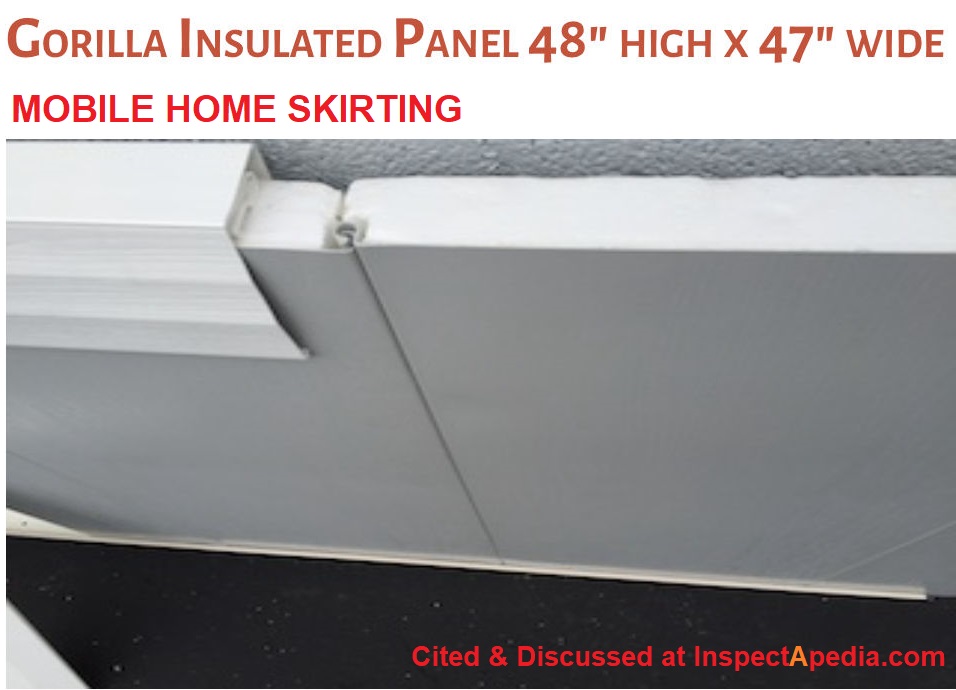 On 2021-09-02 by Alans Services - Where to find white skirting with fiberglass insulation
On 2021-09-02 by Alans Services - Where to find white skirting with fiberglass insulation
Where to find white skirting with [built-in] fiberglass insulation
Moderator Reply: @Alans Services,
Thank you for the question; but we do not recommend using conventional fiberglass insulation in the skirting of a mobile home where there is any possibility that the insulation will come into contact with water or moisture or ground surface.
In our OPINION a better mobile home insulated skirting uses solid foam insulation in skirting panels.
Depending on the country and city where you live, you can buy insulated mobile home skirting panels at building suppliers like Lowes or Menards as well as from companies specializing in mobile home skirting.
Insulated mobile home skirting is also sold by online vendors like skirtingdirect.com who distribute the Gorilla foam board insulated mobile home skirting we illustrate above.
Other mobile home insulated skirting includes Thermal EverRock and similar products that simulate stone (same vendor) and Rapid Wall Insulated skirting distributed by store.mobilehomeadvantage.com/ (800) 853-7119 - quite a bit less costly than the Gorilla product we listed first.
Typically these products use 2-inch Expanded Polystyrene or EPA foam board that has better moisture resistance than would fiberglass.
Other mobile home skirting products include fiber cement board products like those sold by duraskirt.com who claim, incorrectly in our OPINION, that cement board provides the best thermal insulation.
Below is an image of DuraSkirt fiber cement mobile home skirting; it's gray in natural color but can be painted (white as you specified).
It does not, in that fiber cement has a much lower R-value per inch than styrofoam or other actual insulating materials. For example, fiber cement generally has greater thermal conductivity than EPS board.
However fiber cement is durable material and for areas where moisture exposure or other harsh conditions are present, cement board is a good alternative skirting for mobile homes, and it can also be made to appear as if a home sits upon a masonry foundation.
Another online vendor of mobile home skirting (all of these companies also provide skirting vent openings) selling Titan 2" insulated foundation panels for mobile homes is https://mobilehomepartspro.com/

- CRAWL SPACE MOISTURE CONTROL, [PDF] U.S. Department of Energy
- M.H. Service & Supply Co., [no physical address found], DuraSkirt mobile home skirting boards, fiber cement, Tel: 360-419-9909
- Mobile Home Advantage Co., 4255 Westbrook Drive, Unit #226
Aurora, IL 60504 USA Website: store.mobilehomeadvantage.com/ Tel: (800) 853-7119
provides Thermal EverRock and similar products that simulate stone (same vendor) and Rapid Wall Insulated skirting - SkirtingDirect.com 6676 Gunpark Dr.
Boulder, CO, 80301 USA,
(mailing address only)
Tel: 1-800-843-3336 Website: SkirtingDirect.com
Provides EverRock, EverBrick, EverLock, thermal insulated and other home skirting materials and foundation coverings including the Gorilla foam board insulated mobile home skirting shown above on this page. - Manufactured Housing Institute, 1655 Fort Myer Dr, Arlington, VA 22209 USA, Tel: 703-558-0400 Email: info@mfghome.org Website: http://www.manufacturedhousing.org
- Rustique Rapid Wall Insulated Mobile Home Skirting Panels (shown above) provided by various vendors including Mobile Home Outfitters, Website: https://mobilehomeoutfitters.com/ Tel: 720-779-2358
Website excerpt:
The Rapid Wall Insulated Skirting System by Rustique is a maintenance-free, styrofoam-backed foundation system with a 25-year warranty. It's vinyl-clad construction over 1.5" R9 styrofoam delivers the appearance of a traditional concrete foundation without the expense.
Rapid Wall installs in a matter of hours and the additional purchase of access doors allow for easy under-home access at any point along the perimeter of the home.
Rapid Wall comes in 4' x 12' panels and is available in 4 different color options - white, almond, clay or gray panels. No warranty restrictions for back fill and ground contact.
...
Research on The Role of Mobile Home Skirting in Reducing Storm Damage from Hurricanes & Tornadoes
- Ash, Kevin D. "A qualitative study of mobile home resident perspectives on tornadoes and tornado protective actions in South Carolina, USA." GeoJournal 82, no. 3 (2017): 533-552.
- Kim, Jae H., Mohammadtaghi Moravej, Elaina J. Sutley, Arindam Chowdhury, and Thang N. Dao. OBSERVATIONS AND ANALYSIS OF WIND PRESSURES ON THE FLOOR UNDERSIDE OF ELEVATED BUILDINGS[PDF] Engineering Structures 221 (2020): 111101.
Abstract
A popular method of building flood-proofing in coastal regions is the use of stilts or piers to elevate buildings. These elevated building structures are generally well-designed to reduce or withstand the hydrodynamic loading resulting from flooding waters, storm surge and carried debris.
However, design for wind loading on elevated buildings is not well-informed or codified, despite the changes in the elevated buildings’ aerodynamics.
In order to begin developing the body of knowledge regarding wind effects on elevated buildings, a field study on such structures in the coastal region of the Florida Panhandle was conducted following 2018 Hurricane Michael.
In addition, wind tunnel testing on large-scale models of an elevated single-story residential home was performed at the NHERI Wall of Wind Experimental Facility at the Florida International University.
The evidence of floor underside damage from the field study are consistent with trends of pressure patterns from the experimental program. Measured pressure coefficients on the underside of wind tunnel models were significant and frequently of similar or greater magnitude to those on the roof, the latter for which estimation procedures have already been well-established.
These findings show that deliberate design for floor underside pressures are necessary, and provide critical impetus for continued research in order to reduce damages observed in past hurricanes.
Excerpt:
Skirting is commonly attached around the perimeter of manufactured homes to, amongst other purposes, reduce the wind passage through the air gap. Unfortunately, skirting commonly becomes detached in high wind events. - Marshall, Timothy P. WIND SPEED-DAMAGE CORRELATION IN HURRICANE KATRINA JP 1.36 Haag Engineering Co., Dallas, TX
Excerpt:
Generally, the first sign of wind damage is the loss of skirting around the base of a manufactured home followed by displacement of portions of the roof covering (DOD 2). - Marshall, Tim, HURRICANE LAURA DAMAGE SURVEY [PDF] in 34th Conference on Hurricanes and Tropical Meteorology. AMS, 2021.
Excerpt:
Typical wind damage to manufactured homes included loss of skirting, vinyl siding, and asphalt roof shingles. - Rumbach, Andrew, Esther Sullivan, and Carrie Makarewicz. "Mobile home parks and disasters: Understanding risk to the third housing type in the United States." Natural hazards review 21, no. 2 (2020): 05020001.
Sutley, Elaina J., Karen Vazquez, Jae H. Kim, Thang Dao, Blythe Johnston, and Josh Hunt. "Performance of manufactured housing during Hurricanes Irma and Michael." Journal of performance of constructed facilities 34, no. 4 (2020): 04020078.
Abstract
Manufactured homes historically have been some of the most vulnerable structures to earthquakes, tornadoes, and hurricanes. More than 20 million people reside in manufactured homes in the US, leaving many at considerable risk across the country.
Approximately 10% of the nation’s manufactured home stock is in Florida, where they were subjected to 2 consecutive years of intense hurricanes, including 2017 Hurricane Irma and 2018 Hurricane Michael.
This paper presents posthurricane imagery and damage assessment of 279 manufactured homes assessed after each of these hurricanes in Florida.
Predicted and mapped peak and sustained wind speed data were coupled with public database information of manufactured homes and parks in order to identify site locations with particular ranges of wind speeds in the impacted areas. Damage observations at the component- and system-level were presented based on post-Michael reconnaissance imagery.
It generally was observed that manufactured home performance was consistent with historical observations, including 20% of surveyed homes classified as completely destroyed. These findings are intended to highlight the physical vulnerabilities of manufactured housing and to provide impetus for further research and updated standards for safer, affordable housing.
To understand the condition of mobile home insulation and thus to decide what steps are worth taking to reduce home heating or cooling costs for mobile homes, doublewides, and trailers, we need to inspect the structure focusing on leaks, water damage, and especially air leaks around windows and doors. Start reading
Mobile Home Skirting Codes
Moved to MOBILE HOME SKIRTING CODES
...
...
Reader Comments, Questions & Answers About The Article Above
Below you will find questions and answers previously posted on this page at its page bottom reader comment box.
Reader Q&A - also see RECOMMENDED ARTICLES & FAQs
On 2023-09-17 by Heidi - Is leaving the crawlspace as open as possible ( using metal letice skirting) better for hurricanes?
Is leaving the crawlspace as open as possible ( using metal letice skirting) better for hurricanes? Wind can go underneath trailer instead hitting one big " block".
On 2023-09-19 by InspectApedia DF (mod) - NO
@Heidi,
Good question. Short answer, NO.Meanwhile more critical than the skirting is that your mobile homes tie-downs are correctly installed.
From what I've read (Kim 2020 in particlar) to resist wind damage to your home and floor uplift hazards, you should keep the skirting in place around your home, and you should do what you can to be sure it is as well-secured to the home as possible.
Continuing: I emphasize that it's the stabilizing or tie down system that are most important in protecting a mobile home from hurricanes.
About the skirting: you don't give the location of your home, that might be a consideration, but in general, in my OPINION I'd prefer to keep skirting in place and well-secured in hope that it will reduce wind-blown rain from entering the crawl area where it might cause trouble with electrical or other equipment there and where it might risk wetting the underbelly cover and insulation, leading to a mold problem.
You won't be surprised to know that there has been research on the damage suffered by mobile homes during hurricanes and tornadoes - too often we see them flipped over or destroyed, either lacking in tiedowns or improperly secured, or simply overwhelmed by the force of storms that is increasing as a feature of global climate change.At MOBILE HOME STABILIZING SYSTEMS there is research on storm damage to mobile homes and for you, found there, Kim's paper may be of particular interest.
You have, however raised an interesting question.
From the time I spent yesterday researching the role of mobile home skirting in hurricane or storm damage to mobile homes or trailers (manufactured housing in some texts), it was apparent that there is a wind-uplift concern that argues for leaving the skirting in place and making it as secure as you can. (Skirting damage or loss is often one of the first signs of storm damage at a mobile home. )
But implicit in your question is the suggestion that with skirting in place, the home offers a larger surface area to horizontal wind forces.
Kim's research suggests that the horizontal force hazard should be counteracted by proper mobile home tie-downs, and that without skirting there is added a wind uplift hazard. Kim also points out that more research is needed.
So for now our OPINION is what I said earlier:
1. be sure that you have proper tie-downs installed, in good condition, properly secured. This is the most important consideration in avoiding having the home flipped over or blown away.
2. make the skirting as secure as you can to reduce the risk of wind uplift that can reach under a home, lift it up, and flip it over
3. making skirting secure and solid (not lattice as you suggested) also reduces the chance that blown rain soaks electrical wiring or insulation under the home, both of which can cause dangerous or costly damage.
On 2023-07-07 by Lindsay - heat saving vs venting of mobile home crawl space
I live in a climate that has 7 plus months of winter. I understand the point of using insulated panels for energy savings, but code requires cross ventilation for every 150sq ft. Where is my heat saving?
On 2023-07-07 by InspectApedia Publisher (mod)
@Lindsay,
In most building code jurisdictions local officials are familiar with and can accept an alternative crawlspace design that converts crawl spaces from a ventilated space to a closed, insulated, dry, "conditioned" space that might even be heated to avoid freeze risk.
But that's an approach easier to demonstrate for a building that is set on a foundation wall and has a concrete slab floor crawl space.
For a mobile home or manufactured home on piers with skirting, I'd be concerned about the closed, conditioned space approach unless you also are very careful to direct roof spillage and surface runoff away from the crawl area AND to put down an effective 6mi poly vapor barrier on the crawl space floor.
Do that and you can indeed cut your home's energy bill.
On 2022-07-07 by James - pit set skirting requirements for mobile homes
I've been trying to find out as much Info on pit set skirting requirements and not finding much.
Would you please help?
Thank You
On 2022-07-07 by InspectApedia-911 (mod)
@James,
Sure, and thank you for a helpful question.
HUD-7584 Permanent Foundation code contains the standards and specifications for permanent foundations for mobile homes.
There are at least these common options for constructing the skirting for a pit set mobile home:
1. Concrete block stem wall set on poured in place footing
2. Poured concrete stem wall set on a port in place footing.
3. Pre-cast concrete foundation walls placed in sections that bolt together and that may not require a poured footing.
4. Third party manufacturers who sell prefabricated concrete panels used to construct the skirting on a pit set mobile home. An example is
Duraskirt™ concrete skirting panels.
For other readers: a pit set mobile home is one that is placed over an excavated crawl area in order to bring the entries to the mobile home closer to ground level.
Constructing any home over a crawl space that is below ground means you need to be concerned about preventing water entry and rodent entry into that space.
On 2022-02-17 by paul gordon fuller - do I need a vapor barrier under my mobile home to sell it?
As my 1991 built and set (in that same year) "Champion" Mobile home 24'x56' while preparing for sale a prospective buyer took it on himself to have a home inspection done.
The inspector called out that a vapor barrier was not found and would need to be corrected.
In my reading of all the information laid out here, I am concluding that the inspector is in fact, misinformed. The belly wrap itself is the only vapor barrier required providing the home has proper skirting and adequate under floor ventilation as described in this section. My question is: Have I got this?
On 2022-02-17 by Inspectapedia Com Moderator (mod)
@paul gordon fuller,
With all due respect, and having consulted the Wise Lady from Philadelphia, the cost of putting down 6 mil poly as a ground vapor barrier under a mobile home costs less than $60. U.S.If I were selling a home and if that were the only concern raised by a buyer I would leap into my car, run to Home Depot, pickup a roll of poly, pay my $59.98, put down the plastic and close the sale.
On 2021-11-26 by Brad - Can I add foam board behind my skirting
Can I add foam board behind my skirting and if so it says I need a thermal barrier should it be put between foam board and skirting or go barrier foam board then skirting for risk of fire I'm guessing
On 2021-11-26 by Inspectapedia Com Moderator (mod)
@Brad,
Foam board is a thermal barrier. It's not a fire barrier.
The best products for insulated mobile home skirting where insulation is needed are described on the page above where you will see that the foam is included in a metal or vinyl or other sheathing materialBuying skirting that incorporates foam board insulation between other layers of material is in my OPINION more fire safe.
On 2021-01-12 by Connie - how much venting space is needed when installing mobile home skirting
If I use 1x4's would 1/8" space between each be enough venting
On 2021-01-12 by (mod)
Connie
I'll be glad to try to help but I need to understand what we are talking about. I don't know where you are installing one by fours or what we are venting.In general I would caution that 1/8 in spacing between boards is not likely to vent anything in any location particularly because as humidity levels change around or in the structure those boards may increase in size and close at opening completely.
On 2020-06-23 by anthony22687 - how much concrete block do I need to frame in the space under my mobile home?
Wondering how many 8x8x16-in block I would need to lay under a double-wide trailer to frame it in
On 2020-06-23 - by (mod) - use concrete block to enclose mobile home crawl space?
A rough calculation, ignoring the space for mortar joints, would be to calculate the total area to be enclosed
Trailer length x height of each of the four sides, in inches, divided by the face area of your block (8 x 16 inches)
But beware: depending on where you live, codes, and other requirements, you may need to have ventilation under the home, and you certainly need easy access for inspection and repairs.
Why are we using block instead of a more common mobile home skirt?
On 2019-12-10 by Tim - maximum size hole I can have in my skirting on my mobile home in New Mexico?
Wanting to know what is the maximum size hole I can have in my skirting on my mobile home in New Mexico
On 2019-12-11 - by (mod) - maximum opening size in mobile home skirting
Thanks for asking about mobile home skirting codes, Tim - you question pointed out that it was not as easy as it should be to find the answer here.
OPINION: I speculate that a local code inspector won't object to "holes" in the skirting in general as it could be argued these are for venting, as long as the "holes" are screened to keep out rodents (rats, mice, squirrels) or other animals; for example, I've seen mobile homes in which ALL of the skirting was made of perforated aluminum panels.
Question: do I have to put skirting on my mobile home and do I have to change to vinyl siding to sell the home?
Hello could you guys tell me if on my 1974 mobile home trailer do I need to have new vinyl siding and sideskirts to sell it? They tell me it's code that I have to before anyone can buy my trailer and it still has the aluminum siding in pretty good shape - J.D. 2017/11/24 by private email
Reply: skirting yes, siding, no.
Most likely HUD will NOT certify nor finance a home built before 1975 / 76. That doesn't mean you can't sell the home, but it impacts the ability of a potential buyer to finance it - as your attorney will probably confirm.
It would be common in many jurisdictions to require a skirt around a mobile home.
I would be stunned to learn that someone insists that you have to re-side any home in order to sell it - that sounds weird and wrong to me. I haven't found any legal source claiming that to sell a mobile home you have to change its siding from aluminum over to vinyl. However if the siding were in poor condition then repairs or replacement might be needed or recommended.
The local building code official or building department where you live (you didn't give that info) and HUD regulations (that affect the ability of a buyer to finance a home) will be the final legal authorities to answer the questions you pose. Let me know what your building department says.
...
Continue reading at MOBILE HOME INSULATION & VENTILATION - home, or select a topic from the closely-related articles below, or see the complete ARTICLE INDEX.
Or see these
Recommended Articles
- CRAWL SPACE VENTILATION CODES
- HOUSEWRAP AIR & VAPOR BARRIERS
- INSULATION AIR & HEAT LEAKS
- INSULATION LOCATION - WHERE TO PUT IT
- MOBILE HOME CODES, STANDARDS & MANUALS
- MOBILE HOME CRAWL SPACES - how to inspect the mobile home crawl space
- MOBILE HOME ENERGY ZONES
- MOBILE HOME INSULATION BELLY WRAP
- MOBILE HOME INSULATION & VENTILATION
- MOBILE HOME SKIRTING
- MOBILE HOME SKIRTING CODES
- MOBILE HOME STABILIZING SYSTEMS - tie-down requirements for mobile homes
- WINTERIZE A BUILDING
Suggested citation for this web page
MOBILE HOME SKIRTING at InspectApedia.com - online encyclopedia of building & environmental inspection, testing, diagnosis, repair, & problem prevention advice.
Or see this
INDEX to RELATED ARTICLES: ARTICLE INDEX to MANUFACTURED & MOBILE HOMES
Or use the SEARCH BOX found below to Ask a Question or Search InspectApedia
Ask a Question or Search InspectApedia
Try the search box just below, or if you prefer, post a question or comment in the Comments box below and we will respond promptly.
Search the InspectApedia website
Note: appearance of your Comment below may be delayed: if your comment contains an image, photograph, web link, or text that looks to the software as if it might be a web link, your posting will appear after it has been approved by a moderator. Apologies for the delay.
Only one image can be added per comment but you can post as many comments, and therefore images, as you like.
You will not receive a notification when a response to your question has been posted.
Please bookmark this page to make it easy for you to check back for our response.
IF above you see "Comment Form is loading comments..." then COMMENT BOX - countable.ca / bawkbox.com IS NOT WORKING.
In any case you are welcome to send an email directly to us at InspectApedia.com at editor@inspectApedia.com
We'll reply to you directly. Please help us help you by noting, in your email, the URL of the InspectApedia page where you wanted to comment.
Citations & References
In addition to any citations in the article above, a full list is available on request.
- Scott, Bob & Lyn M. Bartges, WEATHERIZING MOBILE HOMES” [PDF] Home Energy, July/August 2004, Website: www.homeenergy.org, copy provided by the U.S. DOE at the link cited below
- US DOE WAP, Midwest Regional Field Office. Midwest Weatherization Best Practices Field Guide May 2007: 191-194.
- In addition to citations & references found in this article, see the research citations given at the end of the related articles found at our suggested
CONTINUE READING or RECOMMENDED ARTICLES.
- Carson, Dunlop & Associates Ltd., 120 Carlton Street Suite 407, Toronto ON M5A 4K2. Tel: (416) 964-9415 1-800-268-7070 Email: info@carsondunlop.com. Alan Carson is a past president of ASHI, the American Society of Home Inspectors.
Thanks to Alan Carson and Bob Dunlop, for permission for InspectAPedia to use text excerpts from The HOME REFERENCE BOOK - the Encyclopedia of Homes and to use illustrations from The ILLUSTRATED HOME .
Carson Dunlop Associates provides extensive home inspection education and report writing material. In gratitude we provide links to tsome Carson Dunlop Associates products and services.



